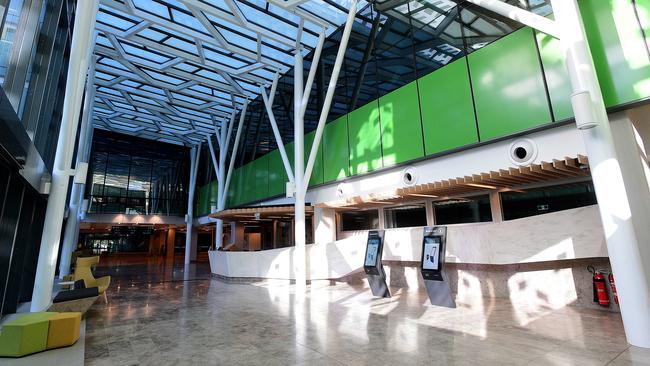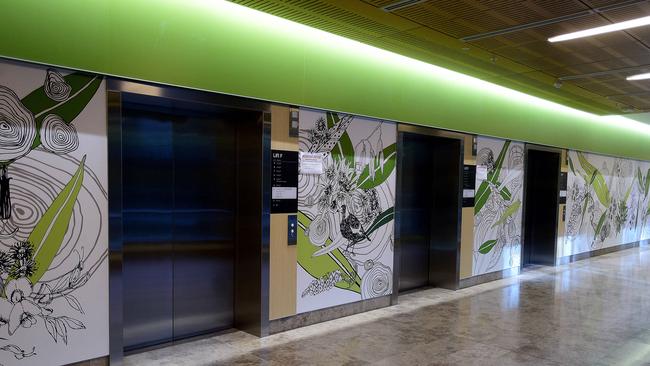STRUCTURAL engineer and earthquake expert Peter McBean is confident the $2.3 billion new Royal Adelaide Hospital will be able to withstand a 1-in-1500-year earthquake, and remain fully operational should a 1-in-500-year earthquake strike.
Which is just as well — in such a worse case scenario, the one place Adelaide will want standing is its flagship new Royal Adelaide Hospital.
In such a situation, the new Royal Adelaide Hospital will switch to “island mode”, being able to operate self sufficiently for at least 48 hours with its own power, water, medical gases, food and other necessities as it deals with a flood of casualties in addition to existing patients.
The advanced design will ensure walls and ceilings do not collapse and everything from lighting and computers to pharmacy supplies and toilets remain operational.

Essential support such as imaging, sterilisation, linen, waste disposal, food, heating and airconditioning will also remain operational.
The west and east plant rooms will be capable of independently supporting the power load in the event of a major failure in either plant room, and the water storage tanks have enough individual capacity to service the hospital in the event of an incident in either water storage tank.
The design conforms with new rules to make hospitals elastic enough to withstand major earthquakes and still be able to function, and is one of the first major structures designed under the upgraded standards. It even incorporates an early warning system that will direct all 48 lifts to stop at the nearest floor and open doors prior to the major ground motion arriving, to avoid entrapment.
While such a scenario may seem remote, Mr McBean notes that an earthquake the size of the one that devastated Christchurch in New Zealand in 2011 occurs in Australia every 10 years, but usually in remote areas.
He says it is a matter of when, not if, an earthquake will hit a major city, and that “Adelaide of all the major cities has the highest likelihood of being hit with a major earthquake”.
This is because Adelaide has 12 known fault lines, more than other capital cities, including the Eden-Burnside fault running from the foothills to the city, and the Para fault which dips ominously under the CBD — like the Christchurch fault — which would release vertical as well as side-to-side shockwaves.
Mr McBean is joint managing director of Wallbridge & Gilbert which won the structural engineering design for the new RAH in late 2010.
As the structural engineer design director for the new RAH, he was just getting down to planning when the Christchurch disaster hit in February 2011.

A skilled search and rescue structural engineer — he runs training courses for emergency services workers — he was in an Australian search and rescue team sent to Christchurch, living for a fortnight in a tent in the city guiding work in dangerously damaged buildings and assessing the extent of the disaster.
He took more than 2500 photographs and the lessons learnt were incorporated into the design of the new RAH.
“I lived in a tent in the city centre for two weeks and we did more than 300 tasks in that time,” he says.
“We documented the failure of structural joints and what we learnt there, just at the start of designing the new RAH, we were able to incorporate into the design.
“It was quite a surreal experience and left a powerful impression. Adelaide’s sister city was broken, it was devoid of people apart from rescuers. “It was so eerie it was like a post-apocalyptic Hollywood film set.
“Everywhere you looked, parapets, awnings, building facades and, in some cases, whole buildings had fallen. Cars on the street were crushed flat by falling debris.

“However it was also a unique opportunity to learn. The new RAH will benefit from the lessons learnt from Christchurch’s misfortune.
“It is the first major Australian facility to be designed since that event, by someone who saw the damage first hand — the DNA of what works and what does not work has been transferred across to this building.”
The new design laws requiring such crucial buildings not to just remain standing but also to keep operating, saw the design team incorporate information from around the world, in particular earthquake-prone California.
This required a lot of work on non-structural components, to ensure the building could continue to function as well has having walls and ceilings remain intact.
Columns, footings, vertical load paths and other factors were considered which required extensive 3D modelling, full-scale modelling and using advanced mathematics, including the “square root of the sum of the squares” method used by engineers to determine overall seismic joint demand.
Mr McBean says an earthquake in Adelaide is a “rare but foreseeable scenario” and is confident that the new RAH will be able to continue in its role as the state’s flagship hospital in such a scenario.

New laws
In 2010, the National Construction Code introduced a new requirement that buildings with a “post-disaster” role, such as the new Royal Adelaide Hospital, must be designed using new standards involving consideration of two distinct earthquake events:
LIFE SAFETY DESIGN in the event of a 1-in-1500-year earthquake (intense ground motion), the design objective is to preserve the lives of people in and around the building. The design aims to prevent collapse; however it is likely significant damage will be sustained;
SERVICEABILITY DESIGN in the event of a 1-in-500-year earthquake (less intense ground motion) the design objective is to ensure the building remains operational for immediate use. There will be damage of a non-structural nature which, once managed, will not interfere with hospital functions.

The design of the new Royal Adelaide Hospital achieves the National Construction Code performance requirements through:
DIVISION of the huge building footprint into smaller sectors, with regular configurations to considerably improve structural reliability;
ALL sectors incorporating a continuous edge beam and redundant structural load paths to improve resilience;
CONTROL of building “drift” or movement during an earthquake through the use of structural walls and cores. Management of the building’s movement is very important in order to limit damage to both structural and non-structural components;
THE building superstructure uses direct vertical load paths without transfer structures of the type which were seen to fail repeatedly in Christchurch;
COLUMN design focusing on limiting axial load ratios and ductility demand to improve gravity frame robustness at design drifts;
CAREFUL attention has been paid to the detailing of reinforcement to ensure adequate bar anchorage and confinement of concrete. In addition, critical joints have been reinforced to overseas standards to ensure ongoing performance under extreme loading conditions;
DYNAMIC structural analysis and the newer displacement-based analysis techniques have been used to establish structural behaviour under earthquake conditions;
A PROBABILISTIC seismic hazard analysis was undertaken for the site to determine the seismic hazard;
CAREFUL co-ordination and co-operation with architectural and services design professionals was necessary to ensure non-structural components achieved the performance required under earthquake conditions.
